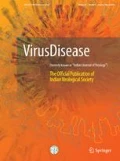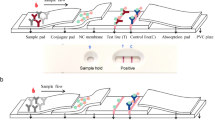Abstract
Equine infectious anemia (EIA)—a retroviral disease caused by equine infectious anemia virus (EIAV)—is a chronic, debilitating disease of horses, mules, and donkeys. EIAV infection has been reported worldwide and is recognized as pathogen of significant economic importance to the horse industry. This disease falls under regulatory control program in many countries including India. Control of EIA is based on identification of inapparent carriers by detection of antibodies to EIAV in serologic tests and “Stamping Out” policy. The current internationally accepted test for diagnosis of EIA is the agar gel immune-diffusion test (AGID), which detects antibodies to the major gag gene (p26) product. The objective of this study was to develop recombinant p26 based in-house immunoassays [enzyme linked immunosorbent assays (ELISA), and AGID] for EIA diagnosis. The synthetic p26 gene of EIAV was expressed in Escherichia coli and diagnostic potential of recombinant p26 protein were evaluated in ELISA and AGID on 7,150 and 1,200 equine serum samples, respectively, and compared with commercial standard AGID kit. The relative sensitivity and specificity of the newly developed ELISA were 100 and 98.6 %, respectively. Whereas, relative sensitivity and specificity of the newly developed AGID were in complete agreement in respect to commercial AGID kit. Here, we have reported the validation of an ELISA and AGID on large number of equine serum samples using recombinant p26 protein produced from synthetic gene which does not require handling of pathogenic EIAV. Since the indigenously developed reagents would be economical than commercial diagnostic kit, the rp26 based-immunoassays could be adopted for the sero-diagnosis and control of EIA in India.





Similar content being viewed by others

References
Alvarez I, Gutierrez G, Ostlund E, Barrandeguy M, Trono K. Western blot assay using recombinant p26 antigen for detection of equine infectious anemia virus-specific antibodies. Clin Vac Immunol. 2007;14:1646–8.
Archambault D, Wang Z-M, Lacal JC, Gazit A, Yaniv A, Dahlberg JE, Tronick SR. Development of an enzyme-linked immunosorbent assay for equine infectious anemia virus detection using recombinant Pr55gag. J Clin Microbiol. 1989;27:1167–73.
Burki F, Rossmanith W, Rossmanith E. Equine lentivirus, comparative studies on four serological tests for the diagnosis of equine infectious anemia. Vet Microbiol. 1992;33:353–60.
Capomaccio S, Willand ZA, Cook SJ, Issel CJ, Santos EM, Reis JKP, Cook RF. Detection, molecular characterization and phylogenetic analysis of full-length equine infectious anemia (EIAV) gag genes isolated from Shackleford Banks wild horses. Vet Microbiol. 2012;157:320–32.
Cappelli K, Capomaccio S, Cook FR, Felicetti M, Marenzoni ML, Coppola G, Verini-Supplizi A, Coletti M, Passamonti F. Molecular detection, epidemiology, and genetic characterization of novel European field isolates of equine infectious anemia virus. J Clin Microbiol. 2011;49:27–33.
Cheeves WP, McGuire TC. Equine infectious anemia virus: immunopathogenesis and persistence. Rev Infect Dis. 1985;7:83–7.
Coggins L, Norcross NL, Nusbaum SR. Diagnosis of equine infectious anemia by immunodiffusion test. Am J Vet Res. 1972;33:11–8.
Cook RF, Cook SJ, Li FL, Montelaro RC, Issel CJ. Development of a multiplex real-time reverse transcriptase-polymerase chain reaction for equine infectious anemia virus (EIAV). J Virol Methods. 2002;105:171–9.
Craigo JK, Montelaro RC. Equine infectious anemia virus (Retroviridae). In: Mahy BWJ, Regenmortel MHV, editors. Encyclopedia of virology, vol. 2. 3rd ed. Los Angeles: Elsevier; 2008. p. 167–74.
Cullinane A, Quinlivan M, Nelly M, Patterson H, Kenna R, Garvey M, Gildea S, Lyons P, Flynn M, Galvin P, Neylon M, Jankowska K. Diagnosis of equine infectious anemia during the 2006 outbreak in Ireland. Vet Rec. 2007;161:647–52.
Dong JB, Zhu W, Cook FR, Goto Y, Horii Y, Haga T. Development of a nested PCR assay to detect equine infectious anemia proviral DNA from peripheral blood of naturally infected horses. Arch Virol. 2012;157:2105–11.
Hammond SA, Li F, McKeon B M Sr, Cook SJ, Issel CJ, Montelaro RC. Immune responses and viral replication in long-term inapparent carrier ponies inoculated with equine infectious anemia virus. J Virol. 2000;74:5968–81.
Issel CJ, Coggins L. Equine infectious anemia: current knowledge. J Am Vet Med Assoc. 1979;174:727–33.
Issel CJ, Foil LD. Studies on equine infectious anemia virus transmission by insects. J Am Vet Med Assoc. 1984;184:293–7.
Kong XG, Pang H, Sugiura T, Matsumoto Y, Onodera T, Akashi H. Evaluation of equine infectious anemia virus core proteins produced in a baculovirus expression system an agar gel immunodiffusion test and enzyme-linked immunosorbent assay. J Vet Med Sci. 1998;60:1361–2.
Malik P, Singha H, Goyal S K, Khurana S K, Kumar R, Virmani N, Shanmugasundaram K, Pandey S B, Ravi K, Singh B K, Singh R K. Serosurveillance of equine infectious anemia virus (EIAV) in equines in India during more than a decade (1999–2012). Ind J Virol. 2013. doi:10.1007/s13337-013-0142-3
Murakami K, Konishi M, Kameyama K, Shibahara T. Detection of equine infectious anemia virus in native Japanese ponies. Vet Rec. 2012;171:72.
Nagarajan MM, Simard C. Detection of horses infected naturally with equine infectious anemia virus by nested polymerase chain reaction. J Virol Methods. 2001;94:97–109.
Nagarajan MM, Simard C. Gag genetic heterogeneity of equine infectious anemia virus (EIAV) in naturally infected horses in Canada. Virus Res. 2007;129:228–35.
Pagamjav O, Kobayashi K, Murakami H, Tabata Y, Miura Y, Boldbaatar B, Sentsui H. Serological survey of equine viral diseases in Mongolia. Microbiol Immunol. 2011;55:289–92.
Pare J, Simard C. Comparison of commercial enzyme-linked immunosorbent assays and agar gel immunodiffusion tests for the serodiagnosis of equine infectious anemia. Can J Vet Res. 2004;68:254–8.
Piza AS, Pereira AR, Terreran MT, Mozzer O, Tanuri A, Brandao PE, Richtzenhain LJ. Serodiagnosis of equine infectious anemia by agar gel immunodiffusion and ELISA using a recombinant p26 viral protein expressed in Escherichia coli as antigen. Prev Vet Med. 2007;78:239–45.
Quinlivan M, Cook RF, Cullinane A. Real-time quantitative RT-PCR and PCR assays for a novel European field isolate of equine infectious anemia virus based on sequence determination of the gag gene. Vet Rec. 2007;160:611–8.
Reis JK, Diniz RS, Haddad JP, Ferraz IB, Carvalho AF, Kroon EG, Ferreira PC, Leite RC. Recombinant envelope protein (rgp90) ELISA for equine infectious anemia virus provides comparable results to the agar gel immunodiffusion. J Virol Methods. 2012;180:62–7.
Reis JK, Melo LM, Rezende MR, Leite RC. Use of an ELISA test in the eradication of an equine infectious anemia focus. Trop Anim Health Prod. 1994;26:65–8.
Salinovich O, Payne SL, Montelaro RC, Hussain KA, Issel CJ, Schnorr KL. Rapid emergence of novel antigenic and genetic variants of equine infectious anemia virus during persistent infection. J Virol. 1986;57:71–80.
Santos EM, Cardoso R, Souza GRL, Goulart LR, Heinemann MB, Leite RC, Reis JKP. Selection of peptides for serological detection of equine infectious anemia. Genet Mol Res. 2012;11:2182–99.
Shane BS, Issel CJ, Montelaro RC. Enzyme linked immunosorbent assay for the detection of equine infectious anemia virus p26 antigen and antibody. J Clin Microbiol. 1984;19:351–5.
Shen DT, Gorham JR, McGuire TC. Enzyme linked immunosorbent assay for detection of equine infectious anemia antibody to purified p26 viral protein. Am J Vet Res. 1984;45:1542–3.
Siegel S, Castellan NJ. Nonparametric statistics for the behavioral sciences. 2nd ed. New York: McGraw-Hill; 1988. p. 1–399.
Soutullo A, Verwimp V, Riveros M, Pauli R, Tonarelli G. Design and validation of an ELISA for equine infectious anemia (EIA) diagnosis using synthetic peptides. Vet Microbiol. 2001;79:111–21.
Suzuki T, Ueda S, Samejima T. Enzyme linked immunosorbent assay for diagnosis of equine infectious anemia. Vet Microbiol. 1982;7:307–15.
Thomas LM, Huntington PJ, Mead LJ, Wingate DL, Rogerson BA, Lew AM. A soluble recombinant fusion protein of the transmembrane envelope protein of equine infectious anemia virus for ELISA. Vet Microbiol. 1992;31:127–37.
Towbin U, Stawnelin T, Gordon J. Electrophoretic transfer of proteins from polyacrylamide gels to nitrocellulose sheets: procedure and some applications. Proc Nat Acad Sci USA. 1979;76:4350–4.
Uppal PK, Yadav MP. Occurrence of equine infectious anemia in India. Vet Rec. 1989;124:514–5.
World Organization for Animal Health (OIE). Equine infectious anemia. In: OIE Terrestrial manual. 2008; pp. 866–870.
Acknowledgments
The authors thank all staff members of the National Research Centre on Equines for skillful technical assistance with serological investigations during the past decades. The help of Sh. Sitaram, Technical Officer and Sh. Gurudutt, skilled supporting staff is highly acknowledged. Thanks are also due to the State Animal Husbandry Department, Vets and equine owners for their cooperation and the Indian Council of Agricultural Research for funding.
Author information
Authors and Affiliations
Corresponding author
Rights and permissions
About this article
Cite this article
Singha, H., Goyal, S.K., Malik, P. et al. Development, evaluation, and laboratory validation of immunoassays for the diagnosis of equine infectious anemia (EIA) using recombinant protein produced from a synthetic p26 gene of EIA virus. Indian J. Virol. 24, 349–356 (2013). https://doi.org/10.1007/s13337-013-0149-9
Received:
Accepted:
Published:
Issue Date:
DOI: https://doi.org/10.1007/s13337-013-0149-9



